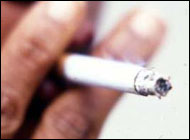Second-hand Tobacco Smoke in Early Infancy Boosts Children’s Allergy Risk
Breathing in second-hand tobacco smoke in early infancy boosts the risk of developing allergies, suggests research published ahead of print in the journal Thorax.
The findings are based on parental survey responses from more than 4000 families about their children’s allergies and the environmental factors to which they had been exposed before and after birth.
These included parental smoking, pet dander (animal hair and dead skin), and foodstuffs.
Parents completed questionnaires when their children were 2 months and 12 months old, and again when they were 2 and 4 years old.
A blood sample was taken from over 2500 children at the age of 4 to look for the presence of immunoglobulin E, or IgE for short.
IgE is an immune system chemical released in response to allergic substances or allergens. High levels indicate ‘sensitisation’ to allergens.
One in 12 mothers (8%) smoked throughout pregnancy, and one in eight (12%) smoked during part of their pregnancy 
But there was no evidence that smoking while pregnant affected a child’s risk of becoming sensitised to certain allergens.
But one parent of one in five children smoked after their baby was born. And around one in 20 children (4%) were exposed to tobacco smoke from both parents.
One in four children had high IgE levels by the time they were 4 years old, with 15% allergic to inhaled allergens, 16% to food allergens, and 7% to both types.
Children exposed to second-hand tobacco smoke in early infancy were almost twice as likely to be allergic to inhaled allergens, such as pet dander, as those who had not been so exposed.
And they were almost 50% more likely to be allergic to foodstuffs.
Only children whose parents were not themselves allergic were affected.
Source: British Medical Journal